Potatoes are called second bread for a reason. Tasty culture has long occupied one of the dominant places in cooking. It is not surprising that people try to preserve the potato harvest harvested in the fall throughout the winter and early spring. For these purposes, a balcony or cellar is usually chosen. Fortunately, many varieties have good shelf life. To prevent the tubers from rotting, freezing or sprouting, you should properly prepare them for storage and monitor the ambient temperature. At what temperature to store potatoes so that they do not spoil or germinate is a pressing question for cellar and basement owners. We will talk further about how to ensure optimal conditions for storing potatoes in a cellar or basement.
Preparing potatoes for storage
Tuber preparation should be carried out at harvest time. Once the potatoes are ripe, they must be harvested immediately. Otherwise, it will begin to collect a large amount of moisture and will not be able to lie for a long time.
Tubers are prepared in several stages:
- Cleaning. You will need to carefully remove the soil from all the tubers. It is not necessary to wash them before sending them to the cellar.
- Drying. The entire crop is scattered in a dry, ventilated area in one layer and allowed to dry completely. The tubers should not be exposed to direct sunlight.
- Sorting. It is recommended to sort out the entire harvest. Sorting is carried out taking into account the size and presence of damage.
- Collection. Dried vegetables are collected in bags and sent for storage.
You can keep tubers both in the basement and at home - on the balcony.
How to protect root vegetables from freezing
It’s not a difficult task to face the fact that potatoes are frozen on the balcony. Here are some tips that can protect it from freezing:
- Tubers sent for storage must be dry. Wet potatoes freeze much faster.
- Untimely insulation of the storage is the reason for freezing of tubers. Often, owners rush to cover supplies only when the temperature has already dropped sufficiently. In such a situation, the potato has time to get the first frostbite, and subsequent actions will no longer bring the desired effect.
- Potatoes left on the balcony are not covered, which causes the top layer to freeze. Be sure to cover the storage container with a lid or, in extreme cases, with insulation (cotton blanket, mattress).
Temperature conditions for storing potatoes in the cellar
When storing potatoes in winter, it is very important to maintain a constant temperature of +2...+4 °C. Deviation in one direction or another is unacceptable. The most common type of storage for potato crops is a traditional cellar. During the storage period, summer residents consistently experience 2 problems that are opposite in nature. Immediately after laying and already in the spring, the main task is to quickly reduce the temperature in the cellar. The problem can be solved using a conventional hood, possibly reinforced with a fan. In the middle of winter, the main danger to the safety of the potato harvest is frost. In this case, the influx of cold outside air should be limited: plug the ventilation ducts with rags, insulate the door to the cellar, etc.
Methods for storing potatoes during storage
You can store potatoes in the cellar in different ways, for example, in bulk, in boxes or bags. Everyone chooses the best option for themselves. But for all these methods there are general rules for preparing the cellar.
Latest articles for gardeners, gardeners and flower growers
Lamp for growing seedlings at home
Lunar calendar for planting tomatoes in March 2021
Varieties of peppers for open ground in the Middle Zone
The best varieties of peppers for a polycarbonate greenhouse
Before bringing potatoes inside, it is worth disinfecting the room. A solution of copper sulfate and lime is suitable. You can also use a concentrated solution of potassium permanganate. Then the cellar is dried. Make sure there is good ventilation. Next, choose a storage method.
When storing in bulk, some nuances should be taken into account:
- this method is good if the harvest is small;
- just a few rotten fruits can ruin most of your potatoes.
The next type of storage is in boxes. Perhaps the most convenient and safe. They are easy to carry if necessary, they are compact and do not take up much space, and they allow air to pass through perfectly.
Sometimes they use bags, but only those made from natural materials. These bags are well ventilated. If a rotten tuber appears, this is not at all scary, since the rotting will not spread outside the bag. Proper storage is only possible if you have followed all the rules.
It’s worth starting preparations in the summer. First, open the cellar and dry it well. Since the cellar freezes very much in winter, it is worth insulating it in order to obtain an acceptable temperature for storing potatoes.
It is necessary to sheathe a wall that is located above the freezing level of the soil with sheets of foam plastic. Such sheets are secured with glue or foam. The roof must be made of wood, the edges must be insulated.
In this case, frost will not penetrate the walls of the cellar.
Options for storage boxes for potatoes on the balcony
Naturally, simply scattering potatoes on the floor of the balcony or putting them in a corner in a fabric bag is a bad idea. In order for this vegetable to be stored for as long as possible and retain its rich taste and beneficial properties, you will have to take care of the equipment of the boxes to place it.
You can do this in several ways:
- Make a box out of wood (boards, clapboards, slats, etc.). In this case, the presence of gaps between the boards will act as ventilation, but this is only suitable for carefully insulated and waterproofed balconies;
- Make a box out of wood without gaps and insulate it. Any foam insulation and a layer of cardboard on top of it, glued from the inside of the box, will create conditions quite comfortable for root vegetables;
Thermal box made by a professional - Process and insulate ready-made wooden or plastic vegetable boxes, which are easy to find in markets or large chain stores - they are often thrown away, so they will definitely give you a couple of boxes;
- Buy plastic boxes or a chest of drawers for storing things and toys, and then lay soft warm fabric or insulation inside it;
- Use an old refrigerator, chest of drawers, drawer table or chair with storage space under the seat for storage;
Box from an old refrigerator - Create boxes with an automatic heating and temperature control system. This option is only possible if you have the necessary skills and funds, since the costs of such equipment can significantly exceed the cost of the potatoes themselves over several seasons;
- Purchase special backpack-type bags designed for storing vegetables on the balcony and hang them on the insulated walls of the room.
Tote bag sold in stores
If you decide to make your own storage, remember that having a lid or at least a warm, opaque material covering the top layers of the potatoes is a must. In the open air, vegetables will quickly dry out or freeze, and they will no longer have any nutritional value.
You can find a limitless variety of fresh and original ideas that will help turn an ordinary balcony warehouse into a full-fledged insulated and well-finished area in the apartment, without losing precious space for storing preparations and vegetables.
An excellent solution is to combine potato storage boxes with pieces of furniture. For example, it is easy to equip an old chest of drawers with storage, and place pots of flowers or a small balcony garden on top of it. A fairly large and tightly put together box with a lid can easily be turned into a cozy sofa or sofa for decorating a lounge area on the balcony.
Convenience and practicality
Storing potatoes in an apartment
Not every summer resident has the opportunity to grow potatoes on his own plot and store them separately in the basement. Many people buy potatoes for the winter and store them in an apartment. At what temperature should potatoes be stored in an apartment? At home, it is unlikely that it will be possible to maintain the temperature within 2-4℃. If possibilities allow, you can equip the pantry with air conditioning. This will allow you to control the microclimate in the room and store any types of root vegetables. At home, it is better to store potatoes on a glassed-in balcony. Ideally, potatoes should be stored in wooden boxes. You can also use bags or nets, but then you will have to cover the root vegetables with blankets so that they do not freeze in winter.
How to store potatoes at home
To avoid problems with the preservation of potatoes, before putting them in boxes, I advise you to carefully sort them and select damaged tubers.
So that when digging potatoes out of the ground, the tubers are less damaged, I use a fork not with sharp, but with wide teeth, and transport the potatoes into the house, in wooden boxes. When culling potatoes for storage, pay attention to the condition of the tubers, make sure that sun-baked fruits do not get into the storage boxes. A fungus can easily grow in them and quickly infect all other tubers.
In good weather, before storing potatoes, lay them out in the yard and dry them well, clearing them of any clods of earth. To store potatoes at home in good conditions, I recommend installing the first row of boxes on stands that will raise them 15 cm above the floor. This is good for ventilation and to prevent the formation of dampness. For the same purpose, I advise you not to place the drawers close to the wall.
In addition to all the precautions listed, I treat the walls of the container with vodka or diluted alcohol. This is a very effective way to combat fungus and rot. If such processing is unacceptable for various reasons, then you can try to process the tubers in other ways.
When storing potatoes at home, the method of sprinkling the tubers with salt or watering them with a salt solution has worked well. At the same time, the fungus, even if it infects several tubers, does not spread to healthy potatoes. There are other folk methods to help potatoes winter well. If ferns grow in the surrounding forests, I advise you to line the bottom and walls of the boxes with ferns. Moreover, even excess humidity will not be an obstacle to the good preservation of vegetables.
There are many folk methods that help you store potatoes at home until spring in good conditions; you just need to listen to the advice of old people, because they are a storehouse of folk wisdom.
But no matter how you ensure the safety of the potatoes, once a month, I strongly recommend inspecting each box. To do this, place an empty box nearby and transfer the tubers into it, conducting a thorough inspection.
If suspicious spots appear, set the potatoes aside. It is quite suitable for food, but for storage it is better to put it aside.
Storage under the sink or kitchen sink
In order to store potatoes in an apartment, choose a dark and cool place with optimal humidity, while avoiding plastic bags or non-breathable, airtight bags. The most optimal thing is a basket made of twigs, but if you don’t have one, don’t worry, you can take a bucket or basin and make holes in it for air circulation.
Storing potatoes on a balcony or loggia
Here's another way to store vegetables, including potatoes, in your apartment. To do this, you can make or buy a box (box) made of boards or other wooden material: timber, pressed sawdust. If the balcony is not glazed and does not have any protection from weather conditions, then insulate the box with foam plastic from the inside and old warm things - jackets, sheepskin coats, fur coats or a blanket from the outside. As you know, polystyrene foam does not decompose and does not break down into components due to temperature changes, and winter clothes retain heat inside.
Tip: if you are faced with the problem of sprouts appearing as you store potatoes, you can put apples or mint leaves in the container. Storing potatoes and these products together ensures their preservation for a long time without visible signs of spoilage or sprouting.
Storing potatoes in the refrigerator
A Khrushchev refrigerator is a cabinet located under the kitchen window. In winter, the temperature varies depending on the weather conditions in your region. It is higher than on the street, but lower than in the apartment. Ideally, if your living space is equipped with this type of “equipment,” then you can install a thermometer that will tell you whether to cover and insulate the potatoes or, conversely, remove all insulation.
In luxury houses or apartments that have undergone major renovations, the Khrushchev refrigerator is made of plastic with a control hole, similar to the neck of a plastic bottle. It’s easier here; if you need a lower temperature, unscrew the lid; if you need a higher temperature, screw it on.
As for the storage itself, the principle is the same as in all previous cases. The only disadvantage of storing it in refrigerators is the small capacity of the product; you must agree that it is not advisable to fill it from top to bottom with just potatoes.
Storage in the entrance or corridor
In office premises the temperature is always lower than in residential ones. But you should take care of the safety of your potatoes, because there will always be a thief for goods stored freely. Therefore, you should put a box with a well-closing lock, or better yet, fix it to the flooring: nail it or screw it with long screws.
It should be remembered that if you choose a corridor entering a living space as a storage method, take care of the optimal humidity of the product.
If the apartment is hot and the temperature is above 26 degrees, then the potatoes may simply dry out, and to prevent this from happening, you can place a cut-off plastic bottle near the storage container in which to control the presence of water.
How to store potatoes in the country
Depending on climatic conditions, it is possible to dig a hole for storing potatoes with a depth of 0.60 - 1.5 meters. The greater the depth of soil freezing in winter, the deeper the hole will need to be dug. But you don’t need to spread the potatoes in a layer of more than 1.5 meters.
Depending on how many potatoes you have, choose the area of the pit.
In most cases, I dig a hole of 2x1.5 meters, and this is enough for me to fit all the potatoes. I always line the bottom of the pit with boards. I also use them to cover the storage area on top, and sprinkle it above with a half-meter layer of dry soil. Then I cover it with thermal insulating natural material.
Dry straw is fully suitable for this.
Before covering the potatoes with boards, I insert a plastic pipe for which I cut a hole in the board. The pipe must extend to the surface at least a meter high and not become clogged with snow in winter. Based on this, I put a rim with a cap on top and secure it with a clamp. This ventilation hole is necessary for good preservation of the potatoes; at the same time, they will rot and rot.
Along with this, the ventilation pipe must reach to the very bottom.
If you do not have the opportunity to arrange a place for storing potatoes in a dry shed or under a good canopy, and you arrange it in the open air, then I recommend making drainage grooves near the hole so that water can flow freely through them without getting into the hole. Under good conditions for loading potatoes into the pit, they will be perfectly preserved until spring.
So that when loading the potatoes do not break and maintain their integrity, I recommend a simple and proven method. Tie the bucket with a rope near the bottom, and tie it to the handle with a second rope. When the bucket lowers to the bottom of the hole with the help of a rope, pulling the second one, you carefully free it from the potatoes.
It is possible to advise another faster loading method, which will make storing potatoes even easier. Build a trench through which the potatoes can easily fall asleep and roll to the bottom of the hole. To prevent the tubers from breaking, make the angle of the slope small, 30 degrees will be enough.
It is very convenient to store seed potatoes in such pits, but it is also possible to perfectly store other vegetables, for example, beets, carrots, radishes, and apples.
Before storing potatoes, make a careful selection, since the tubers must be intact without damage.
PARTNER NEWS
Potatoes turn black inside, what should I do?
Why do potatoes turn black inside when stored? There are several reasons that cause blackening of tubers inside, ranging from improper fertilizer during the cultivation period to violation of storage conditions. Blackness is caused by various diseases that the plant can contract from the soil or from other plants. Some potato varieties are not suitable for long-term storage; they are eaten in early autumn. Excessive watering during cultivation also provokes blackness, as rot forms. Another reason is that the crop was harvested too early: the root crops did not have a thick enough skin to protect them from diseases.
Latest articles for gardeners, gardeners and flower growers
Lunar calendar for planting tomatoes in February 2021
Lunar calendar for planting peppers in March 2021
Strawberry diseases photos and their treatment
How to feed cucumbers in a greenhouse for a good harvest










